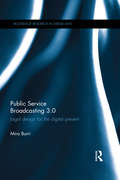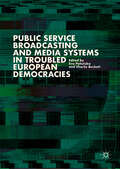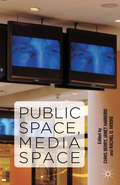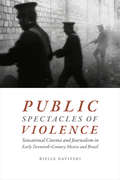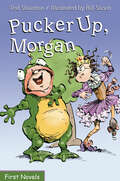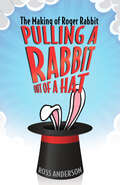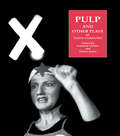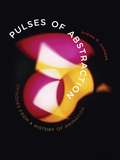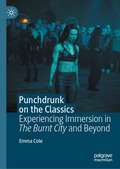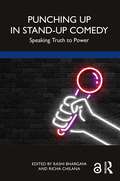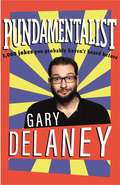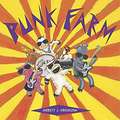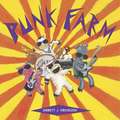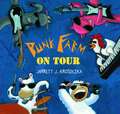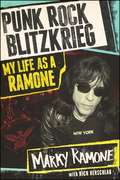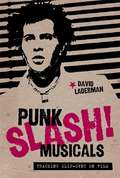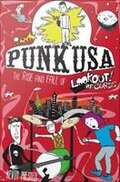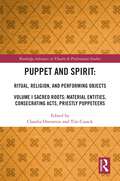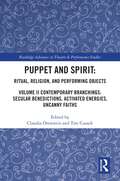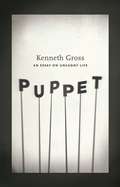- Table View
- List View
Public Service Broadcasting 3.0: Legal Design for the Digital Present (Routledge Research in Media Law #8)
by Mira BurriThe digital media environment is characterized by an abundance and diversity of content, a multiplicity of platforms, new modes of content production, distribution and access, and changed patterns of consumer and business behaviour. This has challenged the traditional model of public service broadcasting (PSB) in diverse ways. This book explores whether and how PSB should adapt to reflect the conditions of the digital media space so that it can effectively and efficiently continue to serve its public mandate. Drawing on literature on media governance in media and communication science, public international law as well as discussions on cyberlaw, Mira Burri maps and critically analyses existing policy and scholarly debates on PSB transformation. She challenges some of conventional rationales for reform, identifies new ones, as well as exposes the limitations placed upon existing and future policy solutions by global media governance arrangements, especially in the fields of trade, copyright and Internet governance. The book goes on to advance a future-oriented model of Public Service Media, which is capable of matching an environment of technological and of governance complexity. As a work that explores how public interest objectives can be pursued efficiently and sustainably in the digital media ecology, this book will be of great interest and use to students and researchers in media law, information technology law, and broadcast media studies, as well as to policy-makers.
Public Service Broadcasting and Media Systems in Troubled European Democracies
by Charlie Beckett Eva PołońskaThis book provides the most recent overview of media systems in Europe. It explores new political, economic and technological environments and the challenges they pose to democracies and informed citizens. It also examines the new illiberal environment that has quickly embraced certain European states and its impact on media systems, considering the sources and possible consequences of these challenges for media industries and media professionals. Part I examines the evolving role of public service media in a comparative study of Western, Southern and Central Europe, whilst Part II ventures into Europe’s periphery, where media continues to be utilised by the state in its quest for power. The book also provides an insight into the role of the European Union in preserving the independence and neutrality of public service media. It will be useful to students and researchers of political communication and international and comparative media, as well as democracy and populism.
Public Space, Media Space: Media, Technology, And The Experience Of Social Space (Public Worlds Ser. #17)
by Chris Berry Rachel Moore Janet HarbordPublic Space, Media Space asks how media saturation are transforming public space and our experience of it. From the role of graffiti and Youtube videos of street art in the Cairo revolution, to OOH (Out of Home) advertising, the book is diverse in its approach and global in its coverage.
Public Spectacles of Violence: Sensational Cinema and Journalism in Early Twentieth-Century Mexico and Brazil
by Rielle NavitskiIn Public Spectacles of Violence Rielle Navitski examines the proliferation of cinematic and photographic images of criminality, bodily injury, and technological catastrophe in early twentieth-century Mexico and Brazil, which were among Latin America’s most industrialized nations and later developed two of the region’s largest film industries. Navitski analyzes a wide range of sensational cultural forms, from nonfiction films and serial cinema to illustrated police reportage, serial literature, and fan magazines, demonstrating how media spectacles of violence helped audiences make sense of the political instability, high crime rates, and social inequality that came with modernization. In both nations, sensational cinema and journalism—influenced by imported films—forged a common public sphere that reached across the racial, class, and geographic divides accentuated by economic growth and urbanization. Highlighting the human costs of modernization, these media constructed everyday experience as decidedly modern, in that it was marked by the same social ills facing industrialized countries. The legacy of sensational early twentieth-century visual culture remains felt in Mexico and Brazil today, where public displays of violence by the military, police, and organized crime are hypervisible.
Pucker Up, Morgan (Formac First Novels)
by Ted StauntonMorgan is delighted to have the lead role in The Frog Prince even if he has to kiss Aldeen, the Godzilla of Grade Three, to turn into a prince. They both agree smooching is gross. Despite Aldeen's threats and Morgan's overreacting they manage to create an unexpected twist to the play. Morgan discovers that teamwork makes a better performance.
Pudsey: A Pup Star's Story
by PudseyLast year, a dog danced his way into the history books as the first canine winner of Britain's Got Talent. On their way to the title, Pudsey and his owner Ashleigh Butler won over Walliams, delighted Dixon, stole the heart of Holden, and utterly captivated Cowell. They charmed the nation, too - with millions of families tuning in to see them take the crown.As a young pup, Pudsey always knew he was somehow different to other puppies. While his brothers and sisters contented themselves with chasing their tails, he sat apart, hoping for something more. Pudsey: A Pup Star's Story tells the story of his incredible, inspirational journey, straight from the dog's mouth.
Pudsey: A Pup Star's Story
by PudseyLast year, a dog danced his way into the history books as the first canine winner of Britain's Got Talent. On their way to the title, Pudsey and his owner Ashleigh Butler won over Walliams, delighted Dixon, stole the heart of Holden, and utterly captivated Cowell. They charmed the nation, too - with millions of families tuning in to see them take the crown.As a young pup, Pudsey always knew he was somehow different to other puppies. While his brothers and sisters contented themselves with chasing their tails, he sat apart, hoping for something more. Pudsey: A Pup Star's Story tells the story of his incredible, inspirational journey, straight from the dog's mouth.
Pulling a Rabbit Out of a Hat: The Making of Roger Rabbit
by Ross AndersonWho Framed Roger Rabbit emerged at a nexus of people, technology, and circumstances that is historically, culturally, and aesthetically momentous. By the 1980s, animation seemed a dying art. Not even the Walt Disney Company, which had already won over thirty Academy Awards, could stop what appeared to be the end of an animation era. To revitalize popular interest in animation, Disney needed to reach outside its own studio and create the distinctive film that helped usher in a Disney Renaissance. That film, Who Framed Roger Rabbit, though expensive and controversial, debuted in theaters to huge success at the box office in 1988. Unique in its conceit of cartoons living in the real world, Who Framed Roger Rabbit magically blended live action and animation, carrying with it a humor that still resonates with audiences. Upon the film’s release, Disney’s marketing program led the audience to believe that Who Framed Roger Rabbit was made solely by director Bob Zemeckis, director of animation Dick Williams, and the visual effects company Industrial Light & Magic, though many Disney animators contributed to the project. Author Ross Anderson interviewed over 140 artists to tell the story of how they created something truly magical. Anderson describes the ways in which the Roger Rabbit characters have been used in film shorts, commercials, and merchandising, and how they have remained a cultural touchstone today.
Pulp and Other Plays by Tasha Fairbanks
by Elaine Aston Gabriele GriffinFirst Published in 2004. Routledge is an imprint of Taylor & Francis, an informa company.
Pulses of Abstraction: Episodes from a History of Animation
by Andrew R. JohnstonReshapes the history of abstract animation and its importance to computer imagery and cinema Animation and technology are always changing with one another. From hand-drawn flipbooks to stop-motion and computer-generated imagery (CGI), animation&’s identity is in flux. But many of these moving image technologies, like CGI, emerged from the world of animation. Indeed, animation has made essential contributions to not only computer imagery but also cinema, helping shape them into the fields and media forms we know today. In Pulses of Abstraction, Andrew R. Johnston presents both a revealing history of abstract animation and an investigation into the relationship between animation and cinema. Examining a rich array of techniques—including etching directly onto the filmstrip, immersive colored-light spectacles, rapid montage sequences, and digital programming—Pulses of Abstraction uncovers important epistemological shifts around film and related media. Just as animation&’s images pulse in projection, so too does its history of indexing technological and epistemic changes through experiments with form, material, and aesthetics. Focusing on a period of rapid media change from the 1950s to the 1970s, this book combines close readings of experimental animations with in-depth technological studies, revealing how animation helped image culture come to terms with the rise of information technologies.
Punchdrunk on the Classics: Experiencing Immersion in The Burnt City and Beyond
by Emma ColePunchdrunk on the Classics: Experiencing Immersion in The Burnt City and Beyond draws attention to Punchdrunk’s use of ancient Greek literature in their creation of immersive theatre. The book documents and analyses the effects of utilising Greek tragedy within both Punchdrunk’s creative development windows, and the company’s final staged productions. It features material stretching from The House of Oedipus (2000) right through to The Burnt City (2022-23), on which the author worked as dramaturg. Chapters include rehearsal studies, explorations of how Greek literature can shape an audience’s experience in immersive theatre, and considerations of how The Burnt City might change our understanding of the poetics of immersion in antiquity. Overall, Punchdrunk on the Classics provides an unparalleled depth of insight into an individual Punchdrunk production, and highlights the until-now overlooked significance of antiquity within Punchdrunk’s practice.
Punching Up in Stand-Up Comedy: Speaking Truth to Power
by Rashi Bhargava Richa ChilanaPunching Up in Stand-Up Comedy explores the new forms, voices and venues of stand-up comedy in different parts of the world and its potential role as a counterhegemonic tool for satire, commentary and expression of identity especially for the disempowered or marginalised. The title brings together essays and perspectives on stand-up and satire from different cultural and political contexts across the world which raise pertinent issues regarding its role in contemporary times, especially with the increased presence of OTT platforms and internet penetration that allows for easy access to this art form. It examines the theoretical understanding of the different aspects of the humour, aesthetics and politics of stand-up comedy, as well as the exploration of race, gender, politics and conflicts, urban culture and LGBTQ+ identities in countries such as Indonesia, Finland, France, Iran, Italy, Morocco, India and the USA. It also asks the question whether, along with contesting and destabilising existing discursive frameworks and identities, a stand-up comic can open up a space for envisaging a new social, cultural and political order? This book will appeal to people interested in performance studies, media, popular culture, digital culture, sociology, digital sociology and anthropology, and English literature.
Pundamentalist: 1,000 jokes you probably haven't heard before
by Gary Delaney'For a collection of good old-fashioned gags, it's one of the best out there, a rich buffet of inventive wordplay that's best savoured a little at a time to fully appreciate the joy of these perfectly-constructed morsels. For original, hilarious gags you'll want to share, this is the real deal.' - Chortle 'A rollicking joyride. . . Pundamentalist has puns for the whole family: rude ones, daft ones, deft ones, stinkers and absolute belters.' - British Comedy GuideGary Delaney, one-liner extraordinaire, has appeared on shows like Mock the Week and written for the likes of Jimmy Carr, Jason Manford, and James Corden. Now, for the first time, comes the first collection of his finest jokes. Featuring the likes of: Garden centres can't reopen fast enough for me, I've been living on borrowed thyme.We can't even afford a garden, so when my girlfriend bought us a trampoline I hit the roof.Sure everyone cares about straws killing dolphins now, but they've been breaking camels' backs for years.Genius is 1% inspiration and 99% perspiration, which explains why Prince Andrew is so stupid.Sad news: The British simile champion has died. We shall not see his like again.My mom doesn't trust my dad's secretary. I asked her why, and she just said 'I've seen her type before'.Today someone told me that I look good with a salt 'n' pepper beard, so I took that as a condiment.My French pen friend just said 'Le Monde', which means the world to me. Can anyone tell me what FOMO stands for? Everyone else seems to know.Actors have got Equity, Magicians have got the Magic Circle, but it's a shame ventriloquists don't have anyone to speak for them.Does anyone know if it's safe to dye your pubes? It's a bit of a grey area.And make sure you look out for Gary's next book, about Stockholm Syndrome: it starts off badly but by the end you'll really enjoy it . . .
Pundamentalist: 1,000 jokes you probably haven't heard before
by Gary Delaney'For a collection of good old-fashioned gags, it's one of the best out there, a rich buffet of inventive wordplay that's best savoured a little at a time to fully appreciate the joy of these perfectly-constructed morsels. For original, hilarious gags you'll want to share, this is the real deal.' - Chortle 'A rollicking joyride. . . Pundamentalist has puns for the whole family: rude ones, daft ones, deft ones, stinkers and absolute belters.' - British Comedy GuideGary Delaney, one-liner extraordinaire, has appeared on shows like Mock the Week and written for the likes of Jimmy Carr, Jason Manford, and James Corden. Now, for the first time, comes the first collection of his finest jokes. Featuring the likes of: Garden centres can't reopen fast enough for me, I've been living on borrowed thyme.We can't even afford a garden, so when my girlfriend bought us a trampoline I hit the roof.Sure everyone cares about straws killing dolphins now, but they've been breaking camels' backs for years.Genius is 1% inspiration and 99% perspiration, which explains why Prince Andrew is so stupid.Sad news: The British simile champion has died. We shall not see his like again.My mom doesn't trust my dad's secretary. I asked her why, and she just said 'I've seen her type before'.Today someone told me that I look good with a salt 'n' pepper beard, so I took that as a condiment.My French pen friend just said 'Le Monde', which means the world to me. Can anyone tell me what FOMO stands for? Everyone else seems to know.Actors have got Equity, Magicians have got the Magic Circle, but it's a shame ventriloquists don't have anyone to speak for them.Does anyone know if it's safe to dye your pubes? It's a bit of a grey area.And make sure you look out for Gary's next book, about Stockholm Syndrome: it starts off badly but by the end you'll really enjoy it . . .
Punk Farm
by Jarrett J. KrosoczkaAfter a long day of work, Farmer Joe goes home to bed. But meanwhile, back at the barn . . . Cow sets up her drums. Pig plugs in his amp. Goat tunes his bass. Chicken sets up her keyboards. And Sheep checks the microphone. They are Punk Farm and tonight they're ready to ROCK! With adorable farm animals - and a surprise tribute to Old MacDonald - this rollicking tale is sure to have kids cheering--and singing--along. From the Hardcover edition.
Punk Farm (Punk Farm Books)
by Jarrett J. KrosoczkaAfter a long day of work, Farmer Joe goes home to bed. But meanwhile, back at the barn . . .Cow sets up her drums.Pig plugs in his amp.Goat tunes his bass.Chicken sets up her keyboards.And Sheep checks the microphone.They are Punk Farm and tonight they're ready to ROCK! With adorable farm animals - and a surprise tribute to Old MacDonald - this rollicking tale is sure to have kids cheering--and singing--along.From the Hardcover edition.
Punk Farm on Tour (Punk Farm Books)
by Jarrett J. KrosoczkaFARMER JOE IS heading off to a Tractor Society Conference in Reno. But meanwhile, back at the farm . . .. . . Cow, Sheep, Pig, Goat, and Chicken are getting ready to rock across the U.S.A. as they set out on a Punk Farm tour! Only, their beat-up old tour van is threatening to ruin their plans. Can the wheels on the van go round and round all the way from Maine to Colorado?This rollicking sequel to Punk Farm will have kids cheering along as their favorite rock star farm animals take the nation by storm!From the Hardcover edition.
Punk Rock Blitzkrieg
by Marky Ramone Richard HerschlagThe inside story behind one of the most revered bands in music history during the early days of punk rock in New York, from legendary drummer Marky Ramone.Rolling Stone ranked the Ramones at #26 on its list of the "100 Greatest Artists of All Time." They received a Grammy Lifetime Achievement Award in 2011 and were inducted into the Rock and Roll Hall of Fame in 2002. And Marky Ramone played a major part in this success--his "blitzkrieg" style of drumming drove the sound the Ramones pioneered. Now, fans can get the inside story. Before he joined the Ramones, Marc Bell was already a name in the New York music scene. But when he joined three other tough misfits, he became Marky Ramone, and the rhythm that came to epitomize punk was born. Having outlived his bandmates, Marky is the only person who can share the secrets and stories of the Ramones' improbable rise from obtuse beginnings to induction into the Rock and Roll Hall of Fame. But it wasn't all good times and hit songs, and Marky doesn't shy away from discussing his own struggles, including the addiction to alcohol that led him to be temporarily kicked out of the band. From the cult film Rock 'n' Roll High School through "I Wanna Be Sedated" through his own struggle with alcoholism, Marky Ramone sets the record straight, painting an unflinching picture of the dysfunction behind the band that changed a generation. With exclusive behind-the-scenes photos, Punk Rock Blitzkrieg is both a cultural history of punk and a stirring story that millions of fans have been waiting for.
Punk Slash! Musicals
by David LadermanPunk Slash! Musicals is the first book to deal extensively with punk narrative films, specifically British and American punk rock musicals produced from roughly 1978 to 1986. Films such as Jubilee, Breaking Glass, Times Square, Smithereens, Starstruck, and Sid and Nancy represent a convergence between independent, subversive cinema and formulaic classical Hollywood and pop musical genres. Guiding this project is the concept of "slip-sync. " Riffing on the commonplace lip-sync phenomenon, "slip-sync" refers to moments in the films when the punk performer "slips" out of sync with the performance spectacle, and sometimes the sound track itself, engendering a provocative moment of tension. This tension frequently serves to illustrate other thematic and narrative conflicts, central among these being the punk negotiation between authenticity and un-authenticity. Laderman emphasizes the strong female lead performer at the centre of most of these films, as well as each film's engagement with gender and race issues. Additionally, he situates his analyses in relation to the broader cultural and political context of the neo-conservatism and new electronic audio-visual technologies of the 1980s, showing how punk's revolution against the mainstream actually depends upon a certain ironic embrace of pop culture.
Punk USA
by Kevin PrestedThrough hundreds of exclusive and original interviews, Punk USA documents an empire that was built overnight as Lookout sold millions of records and rode the wave of the second coming of punk rock until it all came crashing down. In 1987, Lawrence Livermore founded independent punk label Lookout Records to release records by his band The Lookouts. Forming a partnership with David Hayes, the label released some of the most influential recordings from California's East Bay punk scene, including a then-teenaged Green Day. Originally operating out of a bedroom, Lookout created "The East Bay Punk sound," with bands such as Crimpshrine, Operation Ivy, The Mr. T Experience, and many more. The label helped to pave the way for future punk upstarts and as Lookout grew, young punk entrepreneurs used the label as a blueprint to try their hand at record pressing. As punk broke nationally in the mid 90s the label went from indie outfit to having more money than it knew how to manage.
Puppet and Spirit: Volume I Sacred Roots: Material Entities, Consecrating Acts, Priestly Puppeteers (Routledge Advances in Theatre & Performance Studies)
by Claudia OrensteinThis anthology of essays aims to explore the many types of relationships that exist between puppets, broadly speaking, and the immaterial world. The allure of the puppet goes beyond its material presence as, historically and throughout the globe, many uses of puppets and related objects have expressed and capitalized on their posited connections to other realms or ability to serve as vessels or conduits for immaterial presence. The flip side of the puppet’s troubling uncanniness is precisely the possibilities it represents for connecting to discarnate realities. Where do we see such connections? How do we describe, analyze, and theorize these relationships? The first of two volumes, this book focuses on these questions in relation to long-established, traditional practices using puppets, devotional objects, and related items with sacred aspects to them or that perform ritual roles. Looking at performance traditions and artifacts from China, Indonesia, Korea, Mali, Brazil, Iran, Germany, and elsewhere, the essays from scholars and practitioners provide a range of useful models and critical vocabularies for addressing the ritual and spiritual aspects of puppet performance, further expanding the growing understanding and appreciation of puppetry generally. This book, along with its companion volume, offers, for the first time, robust coverage of this subject from a diversity of voices, examples, and perspectives.
Puppet and Spirit: Volume II Contemporary Branchings: Secular Benedictions, Activated Energies, Uncanny Faiths (ISSN)
by Claudia Orenstein Tim CusackThis anthology of essays, a companion to Puppet and Spirit: Ritual, Religion, and Performing Objects, Volume I, aims to explore the many types of relationships that exist between puppets, broadly speaking, and the immaterial world.The allure of the puppet goes beyond its material presence as, historically and throughout the globe, many uses of puppets and related objects have expressed and capitalized on their posited connections to other realms or ability to serve as vessels or conduits for immaterial presence. The flip side of the puppet’s troubling uncanniness is precisely the possibilities it represents for connecting to discarnate realities. Where do we see such connections in contemporary artistic work in various mediums? How do puppets open avenues for discussion in a world that seems to be increasingly polarized around religious values? How do we describe, analyze, and theorize the present moment? What new questions do puppets address for our times, and how does the puppet’s continued entanglement with these concerns trouble or comfort us? The essays in this book, from scholars and practitioners, provide a range of useful models and critical vocabularies for addressing this aspect of puppet performance, further expanding the growing understanding and appreciation of puppetry generally.This book, along with its companion volume, offers, for the first time, robust coverage of this subject from a diversity of voices, examples, and perspectives.
Puppet: An Essay on Uncanny Life
by Kenneth Gross&“Offering endless insights into the strange and archaic world of puppets . . . This is a book of literary mysticism, rich with accrued culture.&” —John Rockwell, The New York Times Book Review The puppet creates delight and fear. It may evoke the innocent play of childhood, or become a tool of ritual magic, able to negotiate with ghosts and gods. Puppets can be creepy things, secretive, inanimate while also full of spirit, alive with gesture and voice. In this eloquent book, Kenneth Gross contemplates the fascination of these unsettling objects—objects that are also actors and images of life. The poetry of the puppet is central here, whether in its blunt grotesquery or symbolic simplicity, and always in its talent for metamorphosis. On a meditative journey to seek the idiosyncratic shapes of puppets on stage, Gross looks at the anarchic Punch and Judy show, the sacred shadow theater of Bali, and experimental theaters in Europe and the United States, where puppets enact everything from Baroque opera and Shakespearean tragedy to Beckettian farce. Throughout, he interweaves accounts of the myriad faces of the puppet in literature—Collodi&’s cruel, wooden Pinocchio, puppetlike characters in Kafka and Dickens, Rilke&’s puppet-angels, the dark puppeteering of Philip Roth&’s Micky Sabbath—as well as in the work of artists Joseph Cornell and Paul Klee. The puppet emerges here as a hungry creature, seducer and destroyer, demon and clown. It is a test of our experience of things, of the human and inhuman. A book about reseeing what we know, or what we think we know, Puppet evokes the startling power of puppets as mirrors of the uncanny in life and art.
Puppetry and Dramaturgy: Western European Plays for Puppet Theatre, 1582–2020 (Palgrave Studies in Theatre and Performance History)
by Didier PlassardThis open access book presents the results and conclusions of research conducted by the author, and assisted by a team of young researchers brought together in the PuppetPlays project funded by the European Research Council. It is the first international survey to examine Western European puppetry through a systematic study of its repertoires, composed by writers or by the puppeteers themselves. From improvised farces to the refined Baroque operas, from the parodies of institutional stages to the experiments of Modernism, from chivalric epics to contemporary dramaturgy, puppet repertoires are extraordinarily diverse. Their performances have been for centuries the only kind of theatre that many people could attend, but also a means of dramaturgical innovation. Their plays have crossed linguistic, geographical and social boundaries, adapting and spreading the great myths and classics of Western culture, and helping to build Europe's cultural identity. The analysis of these repertoires sheds new light on the history of theatre and society. When and how did puppet theatre compete with actors&’ theatre? When and how did it serve as a laboratory for new dramaturgies? Why do writers and performing artists chose to use them today? These questions can only be answered through a close examination of the many forgotten or unpublished sources collected by the PuppetPlays project.
Pure Drivel
by Steve MartinFrom a wildly imaginative meditation on who Lolita would be at age 50 to a skit entitled "I Love Loosely," in which Lucy and Ricky Ricardo play the parts of Hillary and President Clinton, this collection by comic genius Martin is both hilariously funny and intelligent in its skewering of the topic at hand.
